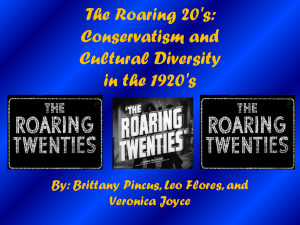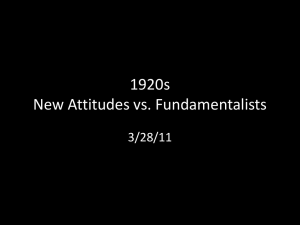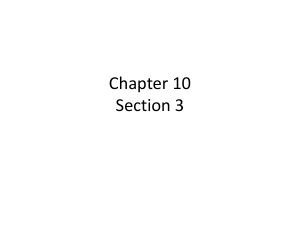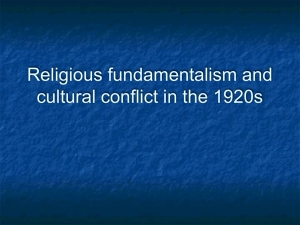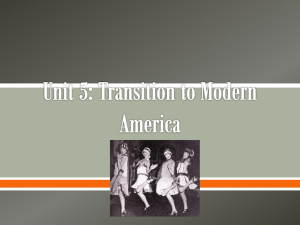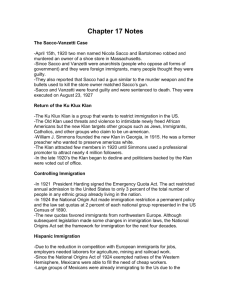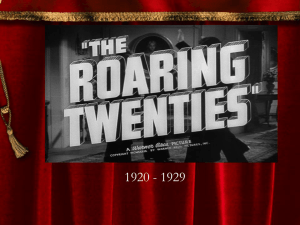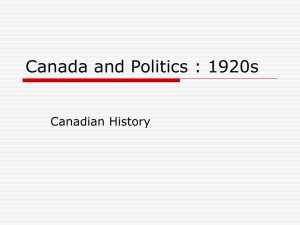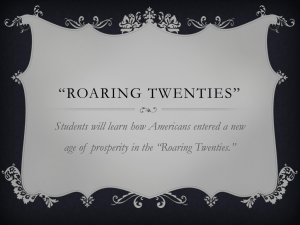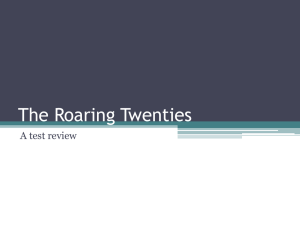The Roaring Twenties - West Essex High School
advertisement
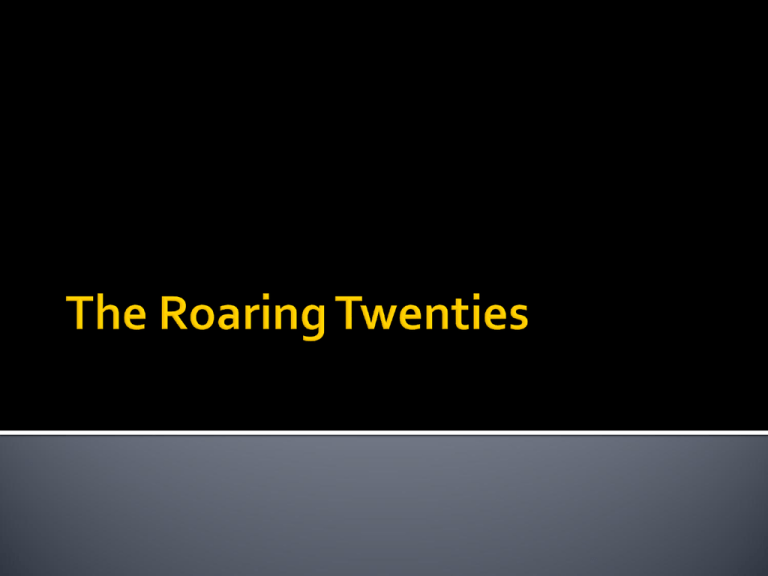
Presidential Election of 1920 Wilson felt election of Democrat James M. Cox would prove that Americans supported the League of Nations and his vision of the role U.S. should play in the world Election of Warren G. Harding would be final rejection of the league ▪ Harding rejected “Wilsonian idealism” ▪ Tired of progressive reforms and foreign crusades ▪ Called for a “return to normalcy” “I’m Normal!!!!” By 1920 the U.S. was an economic giant Richest, most industrialized country in the world U.S. was now largest creditor nation in the world ▪ Other countries owed the U.S. more money than the U.S. owed them The victorious United States came out of the war strong, confident, and prosperous WWI ended in 1918 American businesses that had been operating at full capacity for wartime production were not prepared for war’s abrupt end. Process of demobilization (transition from wartime to peacetime production levels) caused social and economic strains 4.5 million soldiers returning to workforce caused unemployment to rise and wages to fall, and women to be forced out of the positions they had taken when the men had left. Brief but deep recession struck in 1920-21: at war’s end govt. cancelled more than $2 billion in military contracts that were no longer needed, which caused factories to cut back production and lay off workers. ▪ 1921: 5 million workers (12% of labor force) were unemployed ▪ Working conditions for those with jobs were worse than ever Farm crisis added to nation’s economic problems ▪ Farms in Europe started producing again and so markets for American farmers in Europe dried up and caused prices to fall. Workers unsatisfied with conditions who remembered their successes from Progressive Era went on strike: these strikes often turned violent and bloody ▪ More than 3,600 strikes involving 4 million workers occurred in 1919 alone Wave of strikes scared many Americans Fear of Bolshevik revolution erupting in the U.S. led to the Red Scare (period of anticommunist hysteria during 1919 and 1920) ▪ Response to the 1917 revolution in Russia which resulted in the establishment of communist government ▪ Russian government owned and controlled all private property, including every industry and factory. ▪ 1919 Russia’s Bolshevik leader Vladimir Lenin created organization designed to encourage a worldwide communist revolution by overthrowing capitalism and free enterprise: the idea that this might take over in the U.S. frightened many Americans ▪ Some Americans supported Marx’s message of unavoidable workingclass revolution. 1901: Americans formed Socialist Party which foresaw a peaceful transition to socialism by democratic means. ▪ When Bolsheviks seized power in 1917, most of the Social Party refused to support the violent overthrow of the government. ▪ After witnessing the strikes of 1919 however, many believed that anyone tied to Socialism or labor strikes were Bolshevik agents who wanted to overthrow the U.S. government. Americans believed that communists, or Reds, were everywhere. Series of bomb scares in 1919 were interpreted by Americans as justification for their fears. April: postal clerks discovered 36 bombs in mail addressed to prominent citizens. May: bomb damaged house of attorney general. These scares intensified Red Scare hysteria. ▪ Newspapers began demanding harsh action against radicals and attorney general Palmer (whose house was bombed) launched anti-communist crusade ▪ Palmer raids: series of raids to capture radicals. Began in November 1919, peaked in January 1920, when federal officials arrested thousands of suspected radicals in 33 cities nationwide. Most of the people arrested were poor immigrants who had recently arrived in country; most of the time there was no evidence against them but hundreds of foreigners were still deported. Hip Hughes History By summer of 1920 public hysteria over radicalism died down because predictions that communist revolution was close at hand proved unfounded. Although the Red Scare passed, hostility toward foreigners persisted. Most sensational trials of 1920s involved 2 Italian immigrants who were convicted of murder and sentenced to death. •Nicola Sacco: shoemaker •Bartolomeo Vanzetti: peddled fish from pushcart •Charged with murders of paymaster and guard during 1920 payroll robbery outside shoe factory in Boston. Upon arrest, police found the men armed with pistols and after intense interrogation, two were charged with murder. Eyewitnesses who could offer alibis for Sacco and Vanzetti were dismissed. Jury returned a guilty verdict and judge sentenced the two to death. Verdict outraged defenders of civil liberties; argued that they had been convicted not because of the evidence but because they were immigrants. Thousands of people around the world marched in protest but all pleas for a new trial failed. On August 23, 1927, Sacco and Vanzetti were executed •Overview The recession that followed WW1 ended in early 1920s Economy experienced tremendous growth Revolutionary mass-production techniques allowed American workers to produce more goods in less time Presidents Harding and Coolidge supported business to improve economy Cities grow and prosper while farms suffer People in the cities have more leisure time and new innovations that change society ▪ Not all people embrace these changes U.S. played increasingly important role in world business and trade Foreign policy shaped by reaction to WW1 War must never happen again How does the world achieve this goal? Attempts to prevent war. Most American leaders hoped to avoid another war by keeping the rest of the world at an arm’s length. Goal U.S. Action World Court To make judgments in U.S. participation international disputes favored by Harding; voluntarily submitted rejected by Senate by nations. Washington Naval Conference KelloggBriand Pact To reduce arms race and size of navies of major powers. U.S. agreed with leading naval powers to limit construction of warships. To “outlaw war as an U.S. agreed with many instrument of national other nations to renounce war as a policy” means of settling international disputes. Harding Coolidge • President from 1920 to August 1923 when he died suddenly from heart attack •The “average American”: outgoing, back-slapping • Favored big business; worked to reduce government regulation on business • Loved people, not very intelligent: trusted others to make decisions for him –Ohio Gang: close friends he liked to relax and gamble with, saw government service as a chance to get rich •Teapot Dome Scandal: Secretary of Interior Albert Fall took control of oil reserves and leased properties to private oilmen in return for bribes. • Became president in 1923 upon Harding’s death, was elected in 1924, and would have won in 1928 but decided he did not want to run again • “Silent Cal”: quiet, honest, frugal; measured words carefully • Placed trust in business: “The chief business of the American people is business.” • Administration run by men who held to simple virtues of older America • Reduced national debt, trimmed the federal budget, lowered taxes • Oversaw spectacular boom in national economy; prosperity for urban Americans. Traditionalism Modernism •Rural America: farmers • Suffering through hard times • Did not buy new consumer products • Embraced traditional view of religion, science, culture • Formal education not important •Urban America: city-dwellers • Enjoying rising standard of living • Enjoyed new consumer products • Showed openness to social change and new scientific discoveries • Emphasis on formal education for better jobs • Majority were fundamentalists Emphasized Protestant teachings and belief that every word in the Bible was literal truth Believed that the Bible answered every moral and scientific question Scopes “Monkey” Trial Theory of evolution vs. description of Creation in the Bible 1925: Tennessee passed law making it illegal to teach Darwin’s theory of evolution in public schools John Scopes, high school biology teacher, challenged law by teaching evolution and was arrested Emotionally charged trial drew nationwide attention Found guilty of breaking the law and fined $100 “New Immigration” resumed after war’s end New quota system of 1921 controlled immigration from specific countries. Set up formula for the number of immigrants of a specific nationality that could come to America per year Prohibited Japanese immigration to U.S. Immigration restriction was an attempt to turn back the clock to what many saw as a simpler, better time-- a time before the nation became ethnically diverse. Rural Americans who saw the country become more urban and their own position in the nation slip in importance lashed out at symbols of change. Purpose was to freeze America’s existing racial composition, which was largely Northern European Marked end of period of unrestricted immigration that brought 35 million newcomers to U.S. in past century In 1924 Congress passed a discriminatory immigration law that restricted the immigration of Southern and Eastern Europeans and practically excluded Asians and other nonwhites from entry into the United States. This act instituted admission quotas by using the 1890 census to determine the population of a particular nationality group; the government then only allowed 2 percent of that population into the nation. In addition, the act completely barred immigration for all those whom the Supreme Court prohibited from obtaining U.S. citizenship, specifically Asians. The National Origins Act drastically lowered the annual quota of immigration, from 358,000 to 164,000. Congress abolished the national origins quota system in the 1960s. History of 1920s Immigration Video Original Klan had been formed in the South during Reconstruction to terrorize African Americans who tried to vote. During 1920s 800,000 Blacks joined hundreds of thousands of Blacks who moved north in Great Migration. African American population reached 2.5 million This resulted in huge surge of violence and rebirth of the KKK New Klan continued to promote hatred of African Americans, but also aimed at new America in the cities Carried out kidnappings, beatings, and lynchings to terrorize Blacks Targeted Jews, Catholics, immigrants Burned crosses, boycotted businesses owned by anyone who was Jewish, Catholic, African American, and terrorized citizens in the darkness of night. At its height, had 4 to 5 million members Video NAACP African American unions Black nationalism Many grew tired with the slow progress and began to believe that African Americans needed a nation of their own because they would never achieve equality in the U.S. Pan-Africanism: political movement aimed to unite people of African descent worldwide; provided motivation for the idea of forming an independent nation ▪ 1920s: new leader within movement emerged; Marcus Garvey supported cause of black nationalism- aimed to create new political state for African Americans in Africa After recovering from turbulent period of demobilization, U.S. economy soared. Business expansion led to wage increases and with the rise in income, workers now became interested in purchasing new products. Variety of new electric appliances: mixers, food grinders, sewing machines, washing machines, radios, phonographs During 1920s became common for Americans to have electricity in their homes, especially in cities Abundant supply of energy/large network of power plants made this possible By 1930: more than two-thirds of all homes had electricity To keep pace with growing demand for goods, industries increased productivity by using the scientific management approach Based on idea that every kind of work could be broken down into smaller tasks The Model T Henry Ford established automobile company in 1903, 1908: developed the Model T ▪ Sturdy, low-cost automobile ▪ Instant success: sold more than 250,000 a year by 1914 Using scientific management, developed production method of the assembly line which helped factories make goods faster ▪ Workers stood in one place as partially assembled products moved past them on a conveyor belt ▪ Assembly line allowed manufacturers to reduce prices of cars, bringing them within reach of ordinary American families ▪ 1909: $850 ▪ 1924: $290 ▪ Automobile registrations rose from 8 million to 26 million in 1920s: average of one car to every 5 citizens By 1930, cars, trucks, and buses almost completely replaced horse-drawn carriages To accommodate increased traffic, more than 400,000 miles new roads built in 1920s. New structures—billboards, drive-in restaurants, filling stations, tourist cabins—appeared along highways Enabled rural residents to have greater contact with neighbors and more access to shopping and leisure activities Contributed to depopulation of cities as middle-class families moved to the suburbs. Participated in new craze: auto-touring Used cars for camping, picnic, sightseeing vacations Transformed family life Created new social opportunities for teenagers Critics claimed that cars reduced people’s sense of community, and began to cause pollution, traffic jams, parking problems, and higher accident rates. Assembly lines increased productivity but also increased rates of employee turnover Ford increased pay and decreased hours as incentive to keep workers Unskilled factory workers had little chance for advancement beyond assembly line Greater productivity increased number of upper level jobs for clerical workers, managers, salespeople ▪ These jobs required at least a high-school education which few factory workers or recent immigrants had ▪ Discriminatory hiring practices towards African Americans Use of automobile and new electric products decreased availability of some jobs Domestic servants not hired because appliances made housework easier Middle-class families used their car to run errands: limited need for delivery services which led to further unemployment To allow average customers to buy expensive goods, businesses began offering an installment plan Allowed consumers to pay for their cars over time Began using installment plans to purchase many new goods Caused many to begin accumulating debt Industrial designers began to create items that were pleasing to look at as well as functional Advertising became big business in 1920s Fueled demand for all of the new goods Commercial messages appeared in magazines, newspapers, on billboards, and over new medium of radio Companies used slogans, jingles, and celebrity testimonials to fix product names in customers’ minds Chain-style grocery stores began to replace corner markets A&P grew to have 14,000 stores by 1925 New technology allowed stores to stock wide variety of products Overview of causes of economic boom Roaring Twenties Documentary
